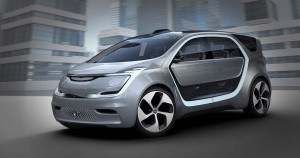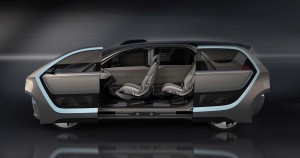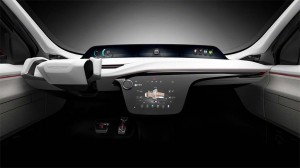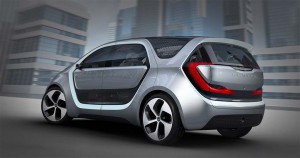Call it a minivan, if you want, but with the debut of the new Portal Concept, Chrysler is looking at an entirely new approach to family transportation.
Making its debut at CES, the annual consumer electronics show in Las Vegas, the Chrysler Portal envisions a “fifth generation” people-mover that is clean, roomy and even roomier than today’s familiar minivans despite a smaller exterior footprint.
Following on the recent launch of the Chrysler Pacifica Hybrid which, despite its name, is actually an extended-range plug-in, the Portal opts for an all-electric drivetrain that can deliver up to 250 miles of range on a charge. And, using one of the new DC Fast Chargers just starting to pop up across the country, the Chrysler Portal can add another 150 miles of driving in less than 20 minutes.
Minivans were the hip form of family transportation in the ‘80s and ‘90s, only to lose momentum in recent years as family buyers have shifted to cooler SUVs and crossovers. The new Pacifica has shown that reports of the minivan’s demise are premature. And with the Chrysler Portal, the automaker is hoping to click with the Millennial generation just starting to enter their parenting years.
“The Chrysler Portal concept is backed by significant research on the Millennial generation,” says Tim Kuniskis, who oversees passenger car brands in North America for Fiat Chrysler Automobiles. “Millennials have clearly defined that they want a long-term vehicle that will grow with them as they experience life changes,” he added, noting that “it was essential that we fully-explored the idea of what a vehicle could look like for this emerging generation.”
He’s not kidding. Millennials – those born between 1982 and 2001 – are the largest generation of Americans ever and by the middle of the coming decade, they will be parents to 75% of all children in the U.S.
The billion-dollar question is what will they want to drive? It’s conventional wisdom that they will want something more environmentally friendly than what previous generations accepted. So, FCA turned to a battery-electric drivetrain, with a single electric motor driving the front wheels. It draws power from an approximately 100 kilowatt-hour lithium-ion battery, about the same size as the pack in the longest-range Tesla offering, the Model X P100d, offering roughly the same range.
(Chrysler Pacifica Hybrid named a finalist for green car of the year. Click Here for the latest.)
The system can be charged with a conventional Level 2 220-volt system or a 350-kilowatt-hour DC Fast Charge system that cuts charging times down to about double the time it takes to fuel up today’s gas-powered minivans.
By moving the batteries under the load floor and all but eliminating the conventional engine compartment, meanwhile, FCA engineers were able to cut almost 19 inches off the overall length of a 2017 Pacifica. Yet the Chrysler Portal offers about the same interior space. The cabin features flexible seating that can slide or fold, as needed, on tracks that run the entire length of the interior. That also makes it easy to remove them entirely to turn the cabin into a large cargo carrier.
“Technology is celebrated throughout with a clean, simple high-mount instrument panel display with easy-to-use interfaces,” Chrysler notes. “Screens can be positioned throughout the interior for ultimate passenger engagement. Up to 10 docking stations, located in the instrument panel and seats, can be used for charging and securing mobile phones and tablet devices.”
There are a variety of high-tech safety features, as well, including radar, LiDAR and camera systems, along with vehicle-to-vehicle and vehicle-to infrastructure technologies, meant to provide full autonomous driving capabilities.
This being CES, there are plenty of other cutting-edge technologies, including facial recognition and voice biometric sensors that ensure security and can customize settings depending upon who’s in the vehicle.
From the outside, the Chrysler Portal picks up where the Chrysler Pacifica leaves off. The lack of a conventional grille clearly signals this is a battery-electric vehicle, and aerodynamics are an obvious and critical part of the design. There’s plenty of glass, including the lower portion of the doors – or, portals, in this case. And both front and back, they slide open providing even easier access to the cabin than with a conventional minivan.
(Google FCA talk autonomous ride-sharing. Click Here for the story.)
The obvious question is when might the Chrysler Portal go from concept to customer? For now, the automaker isn’t saying. But it clearly is looking for ways to enhance the appeal of the minivans that have been a brand mainstay for more than three decades.
As for battery power, tough new mileage and emissions standards will push automakers to adopt zero-emissions systems, and with its large floor under which batteries can be tucked away, a minivan is a good choice to electrify.
Meanwhile, most automakers now expect to begin putting their first self-driving vehicles on the road early in the coming decade. FCA just delivered 100 prototype Pacifica minivans to Waymo, formerly known as the autonomous driving unit of Google. They’re now exploring possible plans to put that technology into retail models.
So, it’s not a stretch to think FCA could bring the Portal, or something like it, into production – and in the not-too-distant future.
(Waymo to show off new autonomous Chrysler Pacifica minivans at Detroit Auto Show. Click Here for more.)





Love the concept, love the sliding front door.
Go for production ASAP.